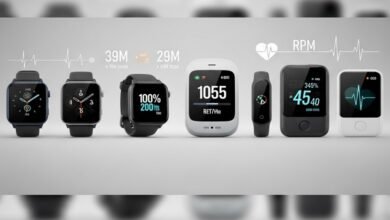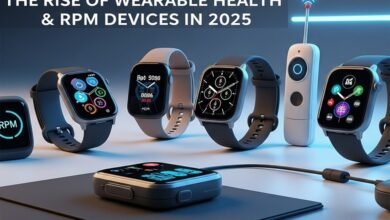Digital & At-Home Care Solutions – A New Era of Wellness & Convenience
The healthcare and wellness industry is experiencing a dramatic transformation. With the rise of telemedicine, AI-driven apps, and smart home devices, people are no longer dependent solely on clinics or hospitals for their everyday health needs. Instead, Digital & At-Home Care Solutions are redefining accessibility, comfort, and personalization in 2025.
From remote consultations to smart monitoring tools, the shift is clear: health and wellness are becoming more patient-centered, tech-integrated, and convenient than ever before. But how do these solutions compare with traditional care, and are they worth the hype? Let’s find out.
📲 What Are Digital & At-Home Care Solutions?
Digital and at-home care solutions include a range of technologies and services designed to bring healthcare and wellness into the home. These can be:
- 🧑⚕️ Telehealth platforms for virtual doctor visits.
- 📱 Mobile health apps that track fitness, sleep, and chronic conditions.
- ⌚ Wearables like smartwatches for real-time monitoring of heart rate, blood oxygen, and stress.
- 🏠 Smart home medical devices, such as digital blood pressure monitors, glucose meters, and AI-powered health scanners.
- 💊 Subscription-based medication delivery and digital pharmacy services.
Together, these innovations create an ecosystem where individuals have greater control over their health, anytime, anywhere.
👀 First Impressions – Convenience at Your Fingertips
The biggest appeal of digital and at-home care solutions is convenience. Imagine consulting a doctor from your couch, or receiving a real-time notification that your heart rate is irregular. These tools make proactive health management possible, unlike traditional healthcare that often focuses on reactive treatment.
- 📞 Telehealth feels immediate and reduces wait times.
- 📡 Wearables give a sense of reassurance through continuous monitoring.
- 🚚 Home delivery services eliminate pharmacy trips.
For many, these solutions feel like a personal health assistant built into everyday life.
⚖️ Digital vs Traditional Healthcare – A Comparison
When comparing digital at-home care with in-person healthcare, both have strengths and weaknesses:
- Accessibility: Digital care makes it easy to reach professionals anytime, especially for people in rural or underserved areas. Traditional care, however, offers hands-on diagnosis and procedures that tech can’t replace.
- Affordability: At-home solutions often lower costs by reducing hospital visits, but they can require upfront investments in devices or app subscriptions.
- Effectiveness: For routine check-ups, monitoring, or chronic disease management, digital tools shine. But in emergencies or complex conditions, traditional hospitals remain essential.
👉 Verdict: Hybrid healthcare is the future—a combination of digital convenience and traditional expertise.
🌍 Why Digital & At-Home Care is Trending in 2025
Several factors are driving the rapid adoption of these solutions:
- 📈 Post-Pandemic Behavior – COVID-19 normalized virtual care and remote monitoring.
- 🤖 AI Integration – Smarter algorithms personalize health advice based on real-time data.
- 🧑💻 Work-From-Home Lifestyle – People are seeking convenience and balance without constant clinic visits.
- 💡 Preventive Healthcare Movement – Focus is shifting toward early detection and lifestyle management.
- 🌎 Global Accessibility – Developing countries are adopting digital platforms to bridge healthcare gaps.
🔄 Product & Service Review – Popular At-Home Solutions
- Telehealth Platforms (e.g., Teladoc, Amwell)
- Provide instant access to doctors and specialists.
- Best for minor illnesses, therapy sessions, and follow-ups.
- Wearables (e.g., Apple Watch, Fitbit, Oura Ring)
- Monitor heart rate, sleep, oxygen levels, and even stress.
- Ideal for those managing chronic conditions or fitness goals.
- Smart Home Devices (e.g., Withings Smart Scales, Omron BP Monitors)
- Offer precise tracking of weight, blood pressure, and more.
- Great for seniors or those with hypertension/diabetes.
- Digital Pharmacies & Subscriptions (e.g., PillPack, Capsule)
- Convenient medication delivery with automatic refills.
- Especially useful for long-term treatments.
📌 User Feedback suggests higher satisfaction with routine care, though some patients still prefer face-to-face reassurance for major concerns.
✅ Pros & ❌ Cons of At-Home Digital Care
✅ Pros:
- Saves time and travel costs.
- Promotes consistent health monitoring.
- Makes healthcare more accessible globally.
- Encourages proactive wellness habits.
❌ Cons:
- Requires reliable internet and devices.
- Not suitable for emergencies or complex care.
- Concerns over data privacy and security.
- Can feel impersonal compared to in-clinic visits.
🥇 Who Should Use Digital & At-Home Care Solutions?
These solutions are best suited for:
- 🌟 Busy professionals who want efficient healthcare.
- 🌟 Elderly patients needing regular monitoring.
- 🌟 Chronic illness patients managing diabetes, hypertension, or heart disease.
- 🌟 Tech-savvy wellness enthusiasts tracking fitness and sleep.
- 🌟 Rural communities with limited access to hospitals.
For maximum benefit, most users adopt a hybrid model—using digital tools for daily care and traditional clinics for advanced treatments.
📌 Final Verdict – The Future of Healthcare is Hybrid
Digital & At-Home Care Solutions are not replacing doctors—they’re empowering patients. They allow individuals to take greater responsibility for their health, reduce costs, and make care more accessible.
While challenges remain (privacy, accuracy, accessibility in low-tech areas), the trend toward digital-first healthcare is irreversible. The future lies in a hybrid ecosystem, where AI-powered monitoring, telehealth, and smart devices work hand-in-hand with traditional hospitals.
👉 If you value convenience, prevention, and personalization, digital and at-home care solutions are worth embracing in 2025 and beyond.



